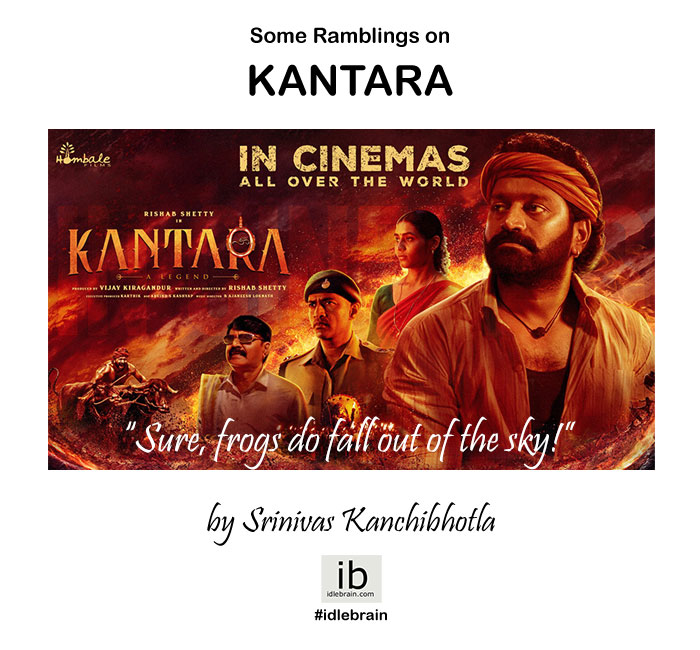
The final shot of Lars Von Trier's "Breaking the waves" is both shocking and pure at once, when the camera pulls back and back and back into and over the clouds, starting off from a modest funeral on a beach, to reveal a pair of huge church bells suspended in air, tolling loudly for the dearly departed down below, extolling the purity of the ultimate sacrifice of a loving wife, fulfilling the most unreasonable of requests that a husband could ever ask of his spouse. When young Narendranath walks up to Paramahamsa to contest about his claims of seeing and conversing with God and asks him whether he, Ramakrishna, can show the God to him, legend has it that Ramakrishna, without batting an eyelid, replies "Sure!". There's no vacillation nor hesitation even for a second there. The space where magic and realism can coexist in the contemporary world might be a mythical to some, but quite a reasonable one for some others. The combination of belief, coincidence, randomness, causality and other innumerable, unquantifiable variables in nature can throw out phenomena that a rational and logical mind fails to explain. Particularly in the un/semi-civilized parts of the world still untainted by the exactitudes of science, there exist wholly different worlds that belie "normal" understanding of nature and defy "regular" laws of physics, where the space that accommodates magic and realism is alive and vibrant. As a philosopher once said, "understanding" is the bane of the human mind, which refuses anything to pass through that doesn't conform to its contours of perception. The real life examples of a little child who could speak several languages, without knowing anything about them, people talking about (verifiable) facts about their past lives and many such paranormal phenomena fall under the "experiencing" category in the balance sheet of human perception, the other being "understanding". While in real life, the inexplicable could simply be brushed off as lores and legends needing no further scientific examination, reel life cannot get away with it as easily. It has to earn that moment, it has to strive for bridging the mythical gap between "understanding" and "experiencing". Paradoxically, magic is easy in real life, but on screen, the magical moment has to be "believable". "Kaanthara" is real, magical, and believable, all at once. And that's quite a miracle!
The interweave of the commercial, mystical, real and topical in equal measures is what makes "Kaanthara" a tough movie to slot into a genre or a category. The setting of the story in the tribal lands and the governmental efforts to "civilize" the local populace by taking over their forest lands and apportion it as per the "civilized" needs of the society, be it regulating the hunting practices, curbing the sale of the fruits of the forest, restricting the movement of the locals within their own lands and many such are plucked right out the headlines of the daily newspapers. The constant struggle among the locals asserting their rights on their native lands, the government sitting far away and making decisions far removed from the native sentiments, and added to the mix, and the opportunits who try to play both the sides acting as conduits between the gullible locals and the ignorant government, finds daily resonance in the bauxite mining case of Vendanta in Orissa or rise of the tribals against their evacuation for building the huge Sardar Sarovar dam during the Narmada Andolan agitation or in the seeimgly near daily tussles between age old traditions of the interiors and the advanced parts of the society. And into such mileu, Rishab Shetty injects the mystical element with a breathtakingly choreographed (and photographed) "Bhootha Kola" dance form, with Varaaha avathara providing the backbone for it. Whether "Varaaha avathara" is innate to that art form or an artistic choice of the director is not clear, it surely proves to be the right metaphor for the subject - Lord Vishnu taking the form of the wild boar to resuce earth plunged into the abyss (of the ocean), reinstating the law of the land (by wresting the Vedas away from the Hiranyaksha who stole it and killing him in the process) and restablishing the tranquility in the land. The brilliance of "Kaanthara" is how it doesn't settle into one groove for more than a few minutes, as it keeps hopping among multiple genres smoothly and seamlessly, from ultra-commercial, slow-motion, heroic elevations in one moment to hair rising mysticism in another to the serene aristic simplicity of wild life documentaries at one instant to rib tickling comedy quite in the next. Rishab Shetty hurls multiple balls into the air at the same time and juggles them all, giving each one just enough air time and just enough moments of inaction.
The music is certainly something to write home about. Without going overboard with tribal beats, as is the wont, the background music as well as the songs keep the "beats" to a minimum as it explores the traditional roots of the sounds especially during the "Bhootha Kola" performance. The background score does not tread the routine route, like the subject, as it keeps pushing itself into unchartered territories with unusual choices. Among the other principal elements, the photography is lock in step with the subject and its mood, capturing the lush locales of coastal Karnataka in a wider angle establishing the terrain, and moving right up to the proceedings in tight frames when events start to close in. While all these act as nice adornments to the feature, the real treat is Rishab's act as the protagonist as he starts off as a regular commercial movie hero and ends up as an artist during the stunning climax sequence. "Kaanthara" is earthy as its traditions, raw as its forests, innocent as its people and enlightened as its spirits. Brilliant!
checkout http://kanchib.blogspot.com for Srinivas's Blog.
